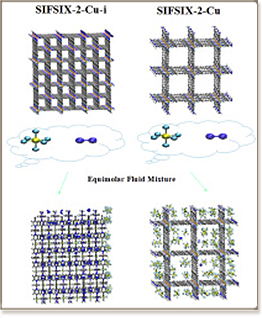


The separation of fluid SF6/N2 mixtures using the recently synthesized metal-organic framework SIFSIX-2-Cu and its interpenetrated polymorph SIFSIX-2-Cu-i has been systematically studied by employing Monte Carlo and Molecular Dynamics simulations. These predictions revealed that SIFSIX-2-Cu shows a high thermodynamic adsorption selectivity for SF6 over N2 combined with one of the highest SF6 uptakes reported so far for an adsorbent. On the other hand, the smaller pore dimensions of the interpenetrated network cause a molecular sieving effect, allowing only the adsorption of N2. Furthermore, the self-diffusivity of the adsorbed SF6 molecules in the SIFSIX-2-Cu framework was predicted to be significantly lower than the one corresponding to N2, while the smaller pore channel network of SIFSIX-2-Cu-i decreases the self-diffusivity of N2 by a factor of about 6. This study revealed that controlling the interpenetration in MOFs is an efficient way to tune their separation performances for strategic gas mixtures.